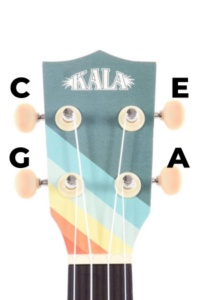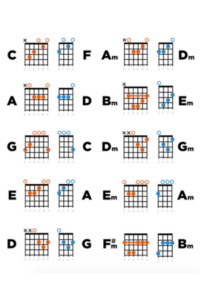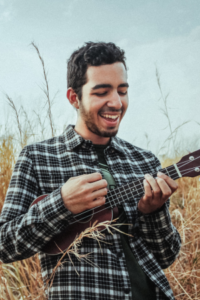Intro to Ukulele For Guitar Players
As we transition from April into the warm month of May, many people have their minds focused on Mother’s Day, Cinco De Mayo, and Memorial Day. But May has another historical significance: it is National Asian American and Pacific Islander Heritage Month! And, as mentioned in our giveaway page, JamPlay is celebrating by highlighting a popular Hawaiian instrument: the ukulele!
But, as you may know, JamPlay is a place to learn guitar. What gives? Well, if you play guitar, you may be enticed to know you can learn the uke very easily too. In fact, many of the chord shapes you already know on the top three strings on the guitar also work on the ukulele. Let’s take a look at what you need to know as a guitar player starting to learn the ukulele!
 Ukulele Standard Tuning
Ukulele Standard Tuning
Probably the least similar aspect between a uke and a guitar is their respective tunings. Standard tuning on a guitar looks like this: E, A, D, G, B, and E in ascending order. On the ukulele, however, the bottom string is tuned higher than the next string up. The standard tuning for a ukulele is C, G, E, and A. So, strings one and four are tuned only a whole step apart.
This might seem confusing at first, especially if it feels like you only just wrapped your head around the guitar’s standard tuning. But remember: there are only four strings on this instrument. This means there are fewer notes you need to keep track of at one time!
 Chord Shapes
Chord Shapes
Despite the different tuning you find on a ukulele, there are a lot of similarities between it and a guitar. For instance, this instrument is fretted, so the notes are easily available to play. And, because of the intervals at which the top three strings on a ukulele are tuned, some of the same chord shapes you know on guitar will work on the uke! But there are some minor differences you’ll have to take into account because of the fourth string (G). Let’s take a look at a video by David Pots for a more in-depth explanation of the chord shapes you can use on the uke.
As David mentions, although some of the chord shapes are the same, the actual chords themselves will be different simply because the uke is tuned differently. For instance, the image above shows what we know as a “C” chord shape on guitar. But, on the ukulele, the notes we play by holding this shape spell an F chord. For more chord charts, check out Dave’s article explaining this further.
 Holding and Strumming a Ukulele
Holding and Strumming a Ukulele
The last tidbits of info you might need before you start your ukulele adventure are how to hold and strum this instrument! Unlike the guitar, the uke is probably too small to rest on your leg and play comfortably. Also, unless designed for it, the uke might not have a place to attach a strap.
So, we’ll have to use our arms to keep the instrument in position. With your left hand, hold the neck of the uke just like you would a guitar. You’ll be fretting notes the same way, after all. Lift the body of the ukulele up and cradle it inside your right elbow. You’ll use your right arm to keep the body of the instrument close to you while you strum.
When strumming a ukulele, it’s uncommon to use a pick or plectrum like we do with a guitar. So, the best way to strum a ukulele is with your fingers! Here’s a strumming tutorial video from Ukulele Magazine:
As Ukulenny explains, strumming on different places on the strings will produce a different tone. You’ll mostly use your thumb or index finger as the plectrum when strumming. Also, instead of moving your whole arm, you’ll want to move your hand at your wrist.
With that concludes our short summary of info you should know when transitioning from the guitar to the ukulele. Good luck on your journey, and happy Asian American and Pacific Islander Heritage Month!
For Song and Guitar Lessons, check out JamPlay.com! JamPlay has over 450 guitar courses from 120+ instructors, and online guitar lessons tailored to every skill level, music genre, and playing style. Click here to learn more.
Share this
Become a JamPlay member for unlimited access to 7000+ guitar lessons and 120+ artists and instructors. View membership plans ›



